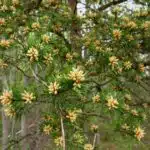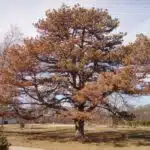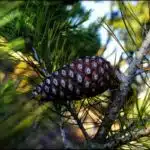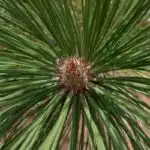Longleaf Pine, also known as Pinus palustris, is a popular tree species that is native to the southeastern United States. This slow-growing evergreen tree can grow up to 100 feet tall with a trunk diameter of 3 feet and can live for over 400 years. The longleaf pine is an important part of the ecosystem and has significant economic value in the form of timber and other forest products.
Growing and caring for longleaf pine requires knowledge of its unique characteristics and needs. As forestry experts, we understand the importance of maintaining healthy forests for future generations, and growing longleaf pine is one way to do so. In this article, we will provide tips on how to successfully grow and care for this valuable species, including information on soil type, planting techniques, fertilization methods, pruning practices, and pest management strategies. By following our advice, you can contribute to the preservation of this iconic species while reaping the benefits of its beauty and usefulness.
Understanding The Unique Characteristics Of Longleaf Pine
Many people are drawn to longleaf pine for its unique adaptations and growth patterns. Longleaf pine is a slow-growing tree that can reach heights of up to 100 feet, with a trunk diameter of up to 4 feet. It is characterized by its long needles, which can grow up to 18 inches in length.
One of the reasons why longleaf pine is so popular is because of its ecological benefits. This species provides important habitat for many animals, including endangered species like the red-cockaded woodpecker. Additionally, longleaf pine forests are known for their ability to withstand natural disasters such as hurricanes and wildfires.
Conservation efforts have been put in place to protect and restore longleaf pine ecosystems. These efforts include prescribed burning, which mimics natural wildfires and promotes the growth of young longleaf pines. Restoration also involves planting new trees in areas where forest cover has been lost due to development or other factors.
Longleaf pine requires specific soil conditions for optimal growth, which will be discussed in detail in the next section. Understanding the unique characteristics of this tree is crucial for anyone interested in growing and caring for it properly. By doing so, we can not only enjoy the beauty of this species but also contribute to conservation efforts that benefit our environment as a whole.
Choosing The Right Soil Type For Longleaf Pine
Understanding the unique characteristics of longleaf pine is crucial before attempting to grow and care for this species. Longleaf pine is a slow-growing tree that can reach up to 100 feet in height with a lifespan of over 300 years. It has long needles that are typically between 8-18 inches in length, and its cones can grow up to 10 inches long.
To ensure that your longleaf pine grows optimally, it’s essential to choose the right soil type. Longleaf pines prefer well-drained soils with an optimal pH range of 5.0 to 6.5. If your soil isn’t naturally acidic, you can adjust it using sulfur or iron sulfate. Additionally, if you’re planting in an area with heavy clay soils, consider amending the soil with organic matter such as compost or peat moss.
Fertilizer requirements for longleaf pine vary depending on site conditions and tree age. Typically, newly planted trees require less fertilizer since they have fewer roots to absorb nutrients from the soil. However, once established, longleaf pines benefit from annual fertilization in the spring or fall using a balanced fertilizer containing nitrogen, phosphorus, and potassium. It’s important not to over-fertilize as this can lead to excessive growth and weaken the tree’s structure.
Moving forward into selecting the best planting techniques is crucial for ensuring your longleaf pine thrives for years to come. Proper planting techniques include selecting healthy seedlings from reputable nurseries, digging holes wide enough for root expansion, mulching around the base of each tree, and watering adequately during establishment periods. By taking these steps and following proper care guidelines such as pruning dead branches and protecting against pests and diseases, you’ll be able to enjoy a beautiful stand of mature longleaf pines on your property for generations to come.
Selecting The Best Planting Techniques
One of the most important aspects of growing longleaf pine is selecting the best planting techniques. Planting density and soil preparation are two essential factors to consider when planting longleaf pine trees. The ideal planting density for longleaf pine is approximately 605 seedlings per acre, with a spacing of 8 feet between each tree. This spacing allows each tree to have enough space to grow and develop properly.
In addition to planting density, soil preparation plays a crucial role in the success of longleaf pine growth. It is recommended to prepare the soil by removing all vegetation and debris from the planting site, followed by tilling or disking the soil to a depth of at least six inches. This method helps ensure that the roots of young trees can penetrate deep into the soil for optimal nutrient uptake.
By carefully selecting your planting techniques, you can give your longleaf pines a better chance of thriving in their new environment. In the next section, we will discuss providing adequate water and nutrients for your trees to maximize growth potential and promote healthy development.
Providing Adequate Water And Nutrients
- Longleaf pine trees require regular watering in order to remain healthy, especially during the early stages of growth.
- Fertilizers should be applied twice a year in the spring and late summer to provide essential nutrients to the tree.
- Soil drainage is important for the health of longleaf pine, as it prevents root rot and helps to aerate the soil.
- Watering should be done deeply and infrequently in order to encourage the development of deep roots.
- Fertilizers should be applied in accordance with the manufacturer’s instructions and with the specific needs of the tree in mind.
- Soil drainage should be assessed regularly, as it is important for the long-term health of the tree.
Watering Longleaf Pine
To ensure the healthy growth of longleaf pine trees, it is crucial to provide adequate water and nutrients. When it comes to watering longleaf pine, it is important to understand the optimal irrigation requirements for these trees. Longleaf pine is a drought-tolerant species that can withstand dry conditions for extended periods. However, it still requires regular watering during its establishment phase.
During the first few years after planting, longleaf pine trees should be watered regularly to encourage strong root development. The amount of water required varies depending on soil type, climate, and other environmental factors. Optimal irrigation amounts can be determined by monitoring soil moisture levels and adjusting watering schedules accordingly. It’s important not to overwater longleaf pines as this can lead to root rot or other diseases.
In summary, proper watering techniques are essential for the survival and growth of longleaf pine trees. While this species can tolerate drought conditions, they still require regular watering during their establishment phase to encourage strong root development. By monitoring soil moisture levels and adjusting irrigation schedules accordingly, forestry experts can ensure that their longleaf pines receive optimal amounts of water without risking overwatering or other potential issues.
Fertilizer For Longleaf Pine
Providing adequate water and nutrients is crucial for the healthy growth of longleaf pine trees. In addition to regular watering, supplying proper fertilizer can also aid in their development. When it comes to fertilizing longleaf pines, there are two options to choose from – organic and chemical fertilizer.
Organic fertilizers are made up of natural materials such as compost, manure, or bone meal. These types of fertilizers release nutrients slowly over time and can improve soil structure and overall health. Chemical fertilizers, on the other hand, are synthetic compounds that release nutrients quickly but can potentially harm beneficial microorganisms in the soil.
The frequency of fertilization depends on several factors including soil type, tree age, and nutrient deficiencies. Longleaf pine trees have specific nutrient requirements that vary throughout their lifespan. During establishment, these trees require higher levels of nitrogen to encourage growth. As they mature, phosphorus becomes more important for root development and overall health. A forestry expert or arborist should conduct soil tests regularly to determine which nutrients need supplementation and how often fertilizer should be applied. By providing proper fertilizer in the right amounts at the right time, longleaf pine trees can thrive and provide numerous benefits to ecosystems and communities alike.
Soil Drainage For Longleaf Pine
Maintaining proper soil drainage is another critical aspect of ensuring healthy growth for longleaf pine trees. Soil drainage refers to the ability of water to move through the soil and away from the roots. Longleaf pines require well-drained soil, as they are susceptible to root rot in wet conditions. Poorly drained soil can lead to stunted growth, decreased vitality, and even death of the tree. The importance of pH levels cannot be overstated, as it directly affects nutrient uptake by the tree.
Mulching techniques can also aid in maintaining proper soil moisture and temperature. Mulch helps retain moisture in the soil, reducing water loss due to evaporation and protecting against drought stress. It also moderates soil temperature by insulating against extreme heat or cold. Organic mulches such as bark or wood chips can improve overall soil structure while providing a slow-release source of nutrients for the tree.
In conclusion, providing adequate water and nutrients is essential for promoting healthy growth in longleaf pine trees. However, it is equally important to maintain proper soil drainage through appropriate mulching techniques and monitoring pH levels. By following these best practices, forestry experts and arborists can ensure that longleaf pines thrive and continue to provide valuable benefits to ecosystems and communities alike.
Pruning Practices For Longleaf Pine
Providing adequate water and nutrients is crucial for the growth and health of longleaf pine trees. However, pruning practices also play a significant role in achieving a healthy and stable tree structure. Pruning frequency and tools used are important factors to consider when caring for longleaf pine.
Pruning frequency depends on the age of the tree and its growth rate. Younger trees require more frequent pruning to encourage proper branching, while mature trees need less frequent pruning to maintain their shape and remove dead or diseased branches. It’s essential to prune during the dormant season to avoid damaging new growth or exposing the tree to pests or diseases.
The right tools are necessary for effective pruning of longleaf pine trees. Hand pruners are useful for small branches, while loppers can handle larger ones. A pruning saw is necessary for thicker branches, and a pole pruner can reach high branches without using a ladder. It’s crucial to keep all tools sharp and clean to prevent damage or infection to the tree. Proper pruning practices help maintain an aesthetically pleasing tree shape while also promoting healthy growth, making it an essential part of longleaf pine care.
Transition: Managing pests and diseases is another critical aspect of caring for longleaf pine trees.
Managing Pests And Diseases
Integrated pest management (IPM) is a crucial aspect of longleaf pine care. It involves the use of multiple strategies to control pests and diseases, with the aim of minimizing environmental impact while maximizing economic benefits. One way to achieve this is by selecting disease-resistant cultivars that are adapted to local conditions. Disease-resistant cultivars have been bred to resist specific diseases, and they can be an effective tool for managing pests in longleaf pine forests.
Another important strategy for managing pests and diseases is monitoring. Regular monitoring helps detect early signs of damage caused by pests or diseases, allowing quick intervention before the problem becomes severe. It also helps identify areas that may be more susceptible to infestations, allowing for targeted treatments. Monitoring can be done through visual inspections, trap surveys, or remote sensing technologies.
Chemical treatments should be used as a last resort in IPM. Instead of relying solely on pesticides, it is better to incorporate other methods such as cultural practices (e.g., planting disease-resistant cultivars), biological controls (e.g., using natural predators), and physical controls (e.g., pruning infected branches). These methods have been shown to reduce pest populations while minimizing environmental impact.
Incorporating IPM strategies into longleaf pine care can help maintain healthy trees while reducing the potential for damage caused by pests and diseases. However, there are other threats that need to be addressed as well. Protecting longleaf pine from wildfires is another critical aspect of forest management that should not be overlooked.
Protecting Longleaf Pine From Wildfires
Wildfire prevention is an important aspect of longleaf pine management. The longleaf pine ecosystem has evolved to withstand periodic fires, but the intensity and frequency of wildfires have increased due to human activities. These wildfires pose a significant threat to the longleaf pine forests, particularly during drought conditions. Therefore, it is crucial to take measures for protecting the species from wildfires.
One way of protecting longleaf pines from wildfire is through fire-resistant landscaping. This method involves creating a buffer zone around the forest using non-flammable materials such as rocks, gravel, or concrete to prevent fire from spreading into the forest. Additionally, maintaining a clear understory by removing dead and low-lying branches reduces fuel load and prevents fires from reaching treetops where they can become uncontrollable.
Another effective way of preventing wildfires in longleaf pine forests is by conducting prescribed burns. Prescribed burns are controlled fires that burn off accumulated fuels on the forest floor and reduce the risk of catastrophic wildfires. These burns also stimulate new growth and maintain healthy ecosystems by promoting nutrient cycling and reducing competition among plant species.
| Fire prevention tips | Explanation |
|---|---|
| Clear debris | Clearing leaves, twigs, and other debris around your home can help prevent fires from starting. |
| Keep lawn hydrated | A well-hydrated lawn is less likely to catch fire than dry grass. |
| Use fire-resistant plants | Plant species such as cacti, succulents, and rockrose do not easily ignite and can create a barrier against flames. |
| Install spark arrestors | Installing spark arrestors on chimneys can prevent embers from escaping and starting fires in nearby vegetation. |
| Create defensible space | Creating a defensible space around your property reduces the risk of damage during a wildfire |
Protecting longleaf pine forests from wildfires requires careful planning and implementation of preventative measures such as fire-resistant landscaping and prescribed burning programs. These methods can help maintain healthy ecosystems and protect the species from catastrophic events. In the next section, we will explore the steps involved in harvesting longleaf pine for timber and other forest products.
Harvesting Longleaf Pine For Timber And Other Forest Products
As a forestry expert, it is ironic to note that while longleaf pine is an excellent choice for timber production, it takes years of growth and care to be ready for harvesting. The tree can take up to 100 years to reach maturity, making sustainable harvesting practices crucial. Due to this lengthy growth period, longleaf pine timber sales are limited compared to other species. However, when harvested correctly, the wood from these trees is highly valued in the market.
Sustainable harvesting of longleaf pine involves careful planning and management. To ensure the forest remains healthy and productive, only a portion of mature trees should be harvested at any given time. It is also essential to protect the saplings and younger trees that will eventually grow into mature ones. This approach protects the biodiversity of the forest ecosystem while allowing for continued economic benefits.
In addition to timber sales, longleaf pine provides other valuable forest products such as pine straw mulch and resin. By utilizing these products sustainably, we can contribute to the preservation of longleaf pine forests for future generations. Proper management practices will ensure that we continue benefiting from this species without causing irreparable damage to the environment or depleting its resources.
Contributing To The Preservation Of Longleaf Pine
Harvesting Longleaf Pine for Timber and Other Forest Products is a crucial process in the longleaf pine ecosystem. However, it is equally important to contribute to the restoration of this ecosystem. Longleaf pine has been greatly depleted over the years due to human activities such as logging and conversion of land to agriculture. To restore this ecosystem, we must employ various restoration techniques.
One of the most effective techniques for restoring longleaf pine is prescribed burning. This technique involves setting controlled fires at specific times of the year to promote new growth and remove invasive species that compete with longleaf pine for resources. Another popular technique is planting longleaf pine seedlings in areas where they have been lost due to deforestation or other factors. Additionally, selective herbicide treatments can be used to control invasive species and promote growth of longleaf pine.
In contributing to the preservation of longleaf pine, it’s essential to use these restoration techniques effectively. It takes time and effort before seeing any significant results, but with persistence, it can be achieved. By restoring this ecosystem, we are not only preserving biodiversity but also ensuring a sustainable future for generations to come.
Moving forward, knowing how to grow and care for longleaf pine is critical in maintaining a healthy ecosystem. Troubleshooting common issues in longleaf pine growth and care includes monitoring for pests such as bark beetles and fungal diseases like fusiform rust that reduce tree health or cause mortality. Proper soil management practices such as fertilization and drainage should also be considered when growing longleaf pine. In our next section, we will explore these issues further and provide solutions on how best to address them while maintaining a healthy ecosystem.
Troubleshooting Common Issues In Longleaf Pine Growth And Care
As any experienced arborist knows, growing and caring for longleaf pine trees can be a challenging task. Even with the right care regimen in place, issues may arise that could negatively impact the tree’s health and growth. In this section, we will discuss some of the most common problems that longleaf pine growers face and provide solutions to help mitigate them.
Identifying signs of distress in longleaf pines is essential to prompt treatment. One such issue is needle cast disease which causes needle loss in infected trees. The telltale sign of this disease is brown or yellow needles that remain attached to the tree even after they have died. Another problem is nematode infection which manifests itself as stunted growth and discolored needles during the summer months.
Treatment options for these issues are varied and depend on several factors, including the extent of damage, type of infection, and tree age. For needle cast disease, removing infected needles from the tree canopy can help reduce further spread. Fungicides application can also be helpful but must be done carefully to avoid harming beneficial insects. Nematode infection requires a more aggressive approach. Soil fumigation has shown positive results in controlling nematode populations; however, it should only be done by a professional arborist due to its potential harm to other organisms in the soil.
As you can see, identifying potential issues early on is critical when it comes to maintaining healthy longleaf pines. With proper care measures in place and prompt treatment when needed, your longleaf pine trees will thrive for years to come without any major setbacks affecting their growth or survival rate.
Conclusion
Longleaf pine is a valuable tree species that requires proper care and management for optimum growth and development. Understanding the unique characteristics of longleaf pine is important in selecting the appropriate planting techniques and providing adequate water and nutrients. Choosing the right soil type is equally important for the healthy growth of longleaf pine.
Pruning practices must be implemented to ensure that the tree grows with a strong structure, while protecting it from wildfires is essential to prevent damage to its ecosystem. Harvesting longleaf pine for timber and other forest products should be done carefully to avoid damaging the remaining trees in the stand. Contributing to the preservation of longleaf pine by planting new seedlings and supporting conservation programs will ensure that this valuable resource remains available for future generations.
In conclusion, growing and caring for longleaf pine requires knowledge, expertise, and dedication. With proper management practices, this valuable tree species can thrive and provide numerous benefits to both humans and wildlife. The careful selection of soil type, planting techniques, water and nutrient provision, pruning practices, wildfire protection measures, harvesting strategies, preservation efforts, and troubleshooting methods are all crucial components of successful longleaf pine management. By following these guidelines, we can ensure a bright future for this majestic tree species.
Image Credits
- “Controlled burn to restore mountain longleaf pine in northwest Georgia – 170317-FS-Chattahoochee-Oconee-SB-002” by ChattOconeeNF (featured)





























